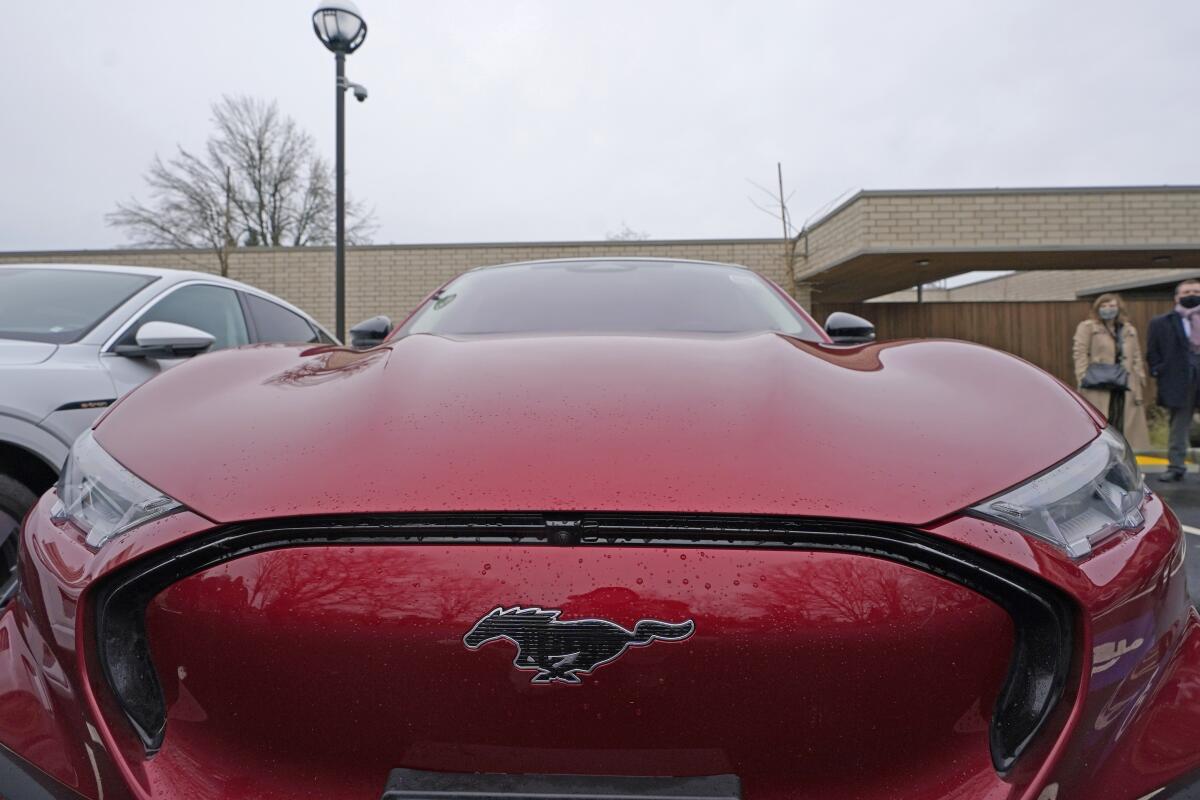Electric cars are in ads, but are there many on dealer lots?

- Share via
Given all the public attention electric vehicles receive — how many Super Bowl commercials for them were there? — you’d think these cars were filling every dealer lot in every corner of California, the state where all new passenger vehicle sales must be zero-emission by 2035. Even though the marketing campaigns of companies like General Motors and Volkswagen would have you believe their EV offerings are just as abundant as their gas-powered lineups, zero-emission cars are still exceedingly rare at the dealers where most of us still buy our new vehicles. As someone who has twice leased an electric car in the last five years (and neither was a Tesla), I feel confident saying that dealers still treat EV buyers as a niche market.
This is just one of the many challenges facing California as it tries to phase out sales of new gas-powered cars completely in the next 13 years. Responding to The Times’ editorial imploring the state to speed this transition, readers identified additional challenges, including the need to update our infrastructure to make vehicle chargers more accessible and the electricity expected to replace gasoline renewable and clean.
—————
To the editor: As the owner of a pure (non-hybrid) electric vehicle, I can attest to the shortage of public chargers. My living situation does not permit me to have a home charger, so I am dependent on that infrastructure.
The existing network of chargers could be made more useful if those using them would be more conscientious about removing their vehicles in a timely manner instead of leaving them at charging stations longer than posted time restrictions. Furthermore, part of the problem is a shortage of “fast-charging” stations, which force drivers who could use them to use the older and more plentiful “Level 2” chargers.
We need to create both incentives to build more such stations, and incentives for drivers to use them.
The other part of the solution is the “stick” rather than the “carrot,” and it’s already working in cities like Santa Monica, where exceeding the posted time limit at charging stations results in a penalty of $1 per minute of overstay, charged to the account used to activate the charger. It doesn’t take more than one such “parking ticket” for drivers to become more conscientious.
But most importantly, EV owners need to show consideration for each other and not monopolize this important shared resource just for themselves.
Kymberleigh Richards, Van Nuys
..
To the editor: Although phasing in electric vehicles will effectively reduce carbon emissions and improve air quality, legislative mandates are far less effective than market forces with regard to vehicle choice.
In the past, the response of auto manufacturers to mandates was to produce a minimum number of “compliance cars” that had little consumer appeal. Tesla, by demonstrating that electric vehicles offer excellent handling, quietness, economy and driving pleasure with few trade-offs, radically shifted consumer preferences (the price of gas helped too).
With improving technology and greater variety, it is likely that consumer demand for gas-powered vehicles will vanish within the decade regardless of mandates. Legislation should rather focus strengthening the power grid, building out charging infrastructure, and supporting research on novel sources of renewable energy and improved battery technology.
Jonathan Kaunitz, Santa Monica
..
To the editor: When Gov. Gavin Newsom signed the executive order in 2020 mandating that by 2035 all new cars and passenger trucks sold in California must be zero-emission, I was amused. Now we have an editorial lauding the mandate as if there will actually be enough cleanly generated electricity running through a grid that has been upgraded to handle it.
With this mandate, the cart is decidedly before the horse. Power is now being completely shut off during Santa Ana wind conditions, and there aren’t many hot days in the summer when my air conditioners haven’t been turned off to keep the entire system from imploding.
Much of this generation is from burning natural gas, cleaner than coal but not much cleaner than modern vehicles. How about some articles lauding new and improved nuclear power plants before we discuss the nonsense of powering all California transportation with electricity?
Everyone wants clean, cheap fuel in their vehicles. Problem is, there just isn’t enough now and likely won’t be in 13 years.
Robert Remillard, Ontario
..
To the editor: Our attitude on climate change seems to be that the next generation will fix it. But if we don’t teach them, how’s that going to work?
The last 35 years of climate communications prove that science, technology, engineering and math, while devising solutions, don’t get them built. Policy does, and policy depends on our histories and cultures, including our failures to value people, lands and waters.
Students need to examine the human factors that hobble or advance climate action. Kids need practice applying each discipline we teach to climate crises.
Locally, the Los Angeles Unified School District’s Board of Education should implement its climate literacy resolution by greening schools in the neediest areas, and with centrally organized and paid field trips, because our kids need to love nature before they can save it. Organize lots of paid professional development where teachers can share what they are doing and their ideas, hopes and anxieties about teaching climate change.
Lucy Garcia, Chatsworth





